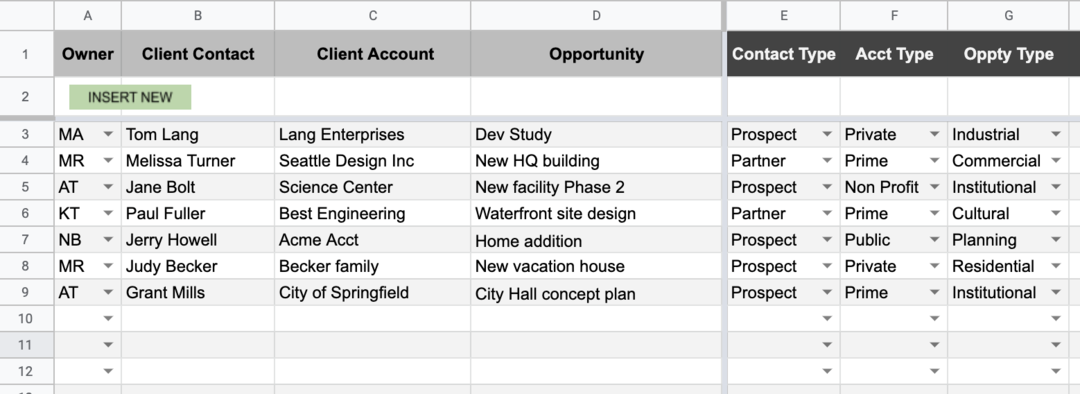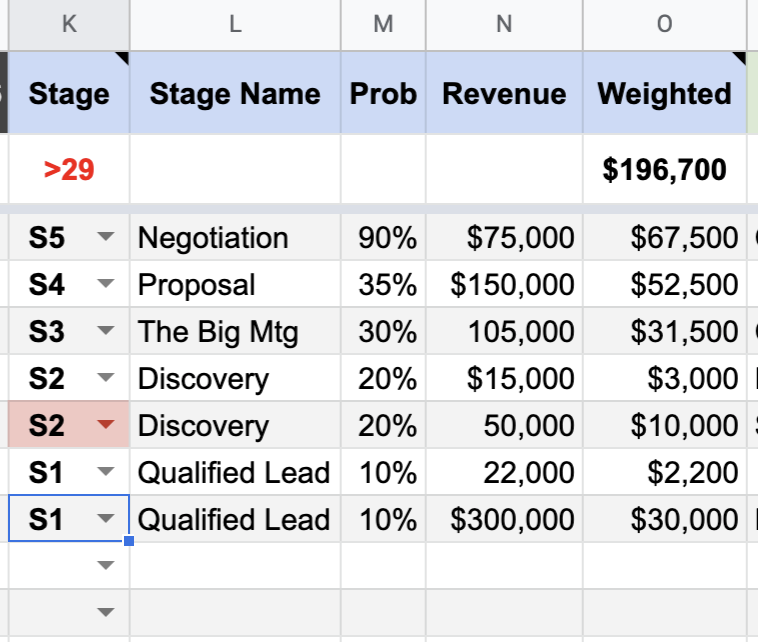You can take control of your foggy, mysterious sales pipeline. This how you do it.

Your sales pipeline is the crystal ball into your future of revenue and work. This related post goes into a bit more detail about what your pipeline is, so I recommend you read it first. Once you’ve got a firm understanding of what we’re talking about, come on back. Then we can dig into unraveling your sales pipeline.
Based on that related post, I was invited to join a great podcast called Rattle & Pedal and hosted by my friends Jeff McKay and Jason Mlicki. We had a great conversation as we dug into the what and also the why behind your sales pipeline. Here’s the link to that 28-minute podcast called “The Pipeline Cliff” that we recorded in the first quarter of 2020.
What’s in your pipeline and what isn’t
There’s enough debate around this that I’m forced to say “It depends…”, but I’ll offer up a few guidelines that you should consider. But before we start making decisions about what’s in or not, everybody needs to get together and empty their pockets. Anyone connected to revenue generation needs to come forward with any current and future new business opportunities of any kind. And then everything needs to get on a list.
Current, pending proposals or responses to Requests for Qualifications or Requests for Proposal are pretty obvious. Those small opportunities from brief telephone calls – the ones “on the side” – should get in there too. Current clients who have additional needs must get on that list as well. Then you start to slice and dice the list.
Any new business opportunity that doesn’t have a specific owner or champion gets the boot. It doesn’t matter if it’s a massive new revenue opportunity or something small. Everything needs to have one, specific owner. Putting something on a list without a champion doesn’t mean everyone owns it. It means nobody does.
Timing is a critical pipeline element. Let’s fast-forward into the future to understand why this is. Once you’ve got your pipeline set, you’ll start to see the average sales cycle duration emerge. This important metric gives you the approximate amount of time it takes an opportunity to enter and then exit your pipeline, win or loss. If a new opportunity won’t contract for 12 months (which is well beyond your average sales cycle duration of, let’s say, 3 months), then it shouldn’t be there. It shouldn’t disappear, but it shouldn’t be counted on for pipeline revenue. Set yourself a calendar reminder to keep track of it.
There are other factors, but the overall consideration is…
Is it a Qualified Opportunity?
Does the client need (as far as you can tell initially) align with your offering? Can you both be successful in this venture? Does this take you and your firm where you want to go or keep you stuck in yesterday? Some firms might call this a “Go/No go” decision-making process. I have a much longer point of view on this that I’m happy to discuss, but I prefer the more nuanced “Go for now” and then “No go if things go sideways” at any point in the sales process… even during the final stages of contract negotiation.
Build the pipeline
Once you’ve got a list, you should start fleshing it out with more information. You can categorize each opportunity into client account types, opportunity types, and other buckets using important criteria. These categories flow into reports that let you know if you’re on track or not. If you’re an architecture firm and want to grow your work on hospitals but only have a small bit of hospital-related revenue in your pipeline, you need to know that and make some changes to how you find that work.
Maybe your list (likely a spreadsheet) is starting to look something like this:

There are many ways to do this. Your firm might even have a Customer Relationship Management system (CRM) where this information lives. Getting a list like this in the the CRM system might be straightforward, or it might be very hard. I favor simple tools that give you all the information you need.
Your list should incorporate sales stages and revenue. Sales is a process that has multiple, progressive steps, and each opportunity should reflect its status. Typical sales stages are Qualification, Discovery, Proposal, Negotiation, and Close. Marketing has a process of their own to create Awareness, Engage an audience, and create Prospects. That sits in front of the sales process. This marketing “funnel” is important to build a process and organization around, but it’s not revenue you can count on anytime soon, so people, companies, or “possible” opportunities that are in your marketing funnel are not in your sales pipeline.
Weight your pipeline revenue
You should list both contract revenue and weighted revenue on your pipeline. There is debate on this subject (in various wonky sales circles), but weighted revenue gives you a realistic view of pipeline revenue and the ability to tweak the relative probability of each opportunity. Early stage opportunities are weighted less while advanced opportunities – those at the Proposal or Negotiation stages – are weighted more. For example:

An opportunity with a total potential contract value of $300,000 might be “weighted” at 10% probability to close at the Qualification stage, giving you $30,000 in weighted pipeline revenue. Another $75,000 opportunity weighted at 90% when it reaches the Negotiation stage represents $67,500 of pipeline revenue. Other stages fall in between somewhere, preferably on the lower end to keep things realistic. And yes, you should ask me what The Big Meeting is.
Obviously, if you win a new $300,000 contract, you are expecting all of that revenue. From that perspective, weighting can seem illogical and confusing. But if you need to get a realistic overview of the entire value and health of your sales pipeline, weighting is the best method. And it’s much more accurate than just shooting for a $3M pipeline if your goal is $1M in revenue and you win 1/3 of the work on average.
Focus on activities. Rather, obsess over activities.
Once a new opportunity makes it onto your sales pipeline, the most important bit of information is the next activity and the due date for that activity. An opportunity without a clear next step is a major problem. It signals that it might not be a big priority for the opportunity owner OR the client. No future activity creates the confusion and fog people have come to expect from a languishing sales effort.

Imagine your new business opportunity as a chain and the links in that chain are specific activities. New activities are connected to completed ones, keeping the conversation going and the chain strong. A broken or missing link is a gap in the chain that sacrifices the integrity of the chain and puts the opportunity in jeopardy.
The next activity should be tied to “advancing” the opportunity. “Check-ins” are easy and often unavoidable, but without purpose and intention, your “check-in” can be ignored. And the next activity is often not “Close. The. Deal.” but rather small, deliberate moves that build on the previous conversations and sustain good energy and momentum. Great opportunities don’t limp across the finish line – they fly through it.
Managing all of this
Regardless of the size and complexity of your sales pipeline, someone needs to own it. One single person needs to manage it and hold individuals accountable for it. This does not mean that one person should update it on everyone’s behalf. Opportunity owners need to both execute strategies and tactics around their individual new business opportunities and update the list. They need to own it.
The sales manager, or whatever title you assign to the person that holds people’s feet to the fire, should work with people 1-on-1 to review their opportunities. Sales managers help individuals define appropriate next steps and then hold them accountable to execute those steps.
Pipeline reviews should not happen in large rooms with lots of people. These group pipeline reviews range from public shaming events to black holes of accountability. If your goal is to have a group review of very general trends and reports, then these large meetings are fine. If you want to Get Things Done, meet 1-on-1.
The kitchen sink
Here is the big, long list of everything I include on my sales pipelines:
- Opportunity owner
- Client contact
- Client account
- Opportunity name
- Various “Type” fields for reporting like Account Type, Opportunity Type, etc.
- Sale Stage name
- Sale Stage code (for sorting in ascending or descending order)
- Probability percentage (often associated with Sales Stage, but editable)
- Total contract revenue
- Weighted revenue
- Next sales activity
- Activity due date
- A satisfying checkbox to check when the activity is completed!
- The opportunity close date (when the ink is dry) and a nice little checkbox
- Opportunity age (the total duration of the sales cycle in days)
- Other dates including Sales Start, Creation (if different than actual sales start), Stage duration, and other good indicators of time
I’ve developed a fairly complex Google Sheet with various add-ons, functions, and scripts that can email PDF reports, send email reminders for upcoming activities and close dates, and archive various bits of information when the checkboxes are checked. Your version doesn’t need to include these things, but your sales team would love it if it did.
Take control of your pipeline
An organized, accurate, and up-to-date sales pipeline is a powerful tool. As mentioned in that previous podcast, your excellent sales pipeline let’s you plan for future revenue and associated resources, gives your team the confidence to say no to bad deals, and reflects the future firm you dream to be.
You have the ability – and the right – to take control of the future of your firm. It starts with your pipeline.
Wainwright Insight provides fractional sales management and sales consulting to organizations who want to take control of their pipeline and build future sales leaders—but could use a little, part-time expertise. I work with professional services firms, and the experts in those firms, who need to get better at chasing and winning big deals when the stakes are high.